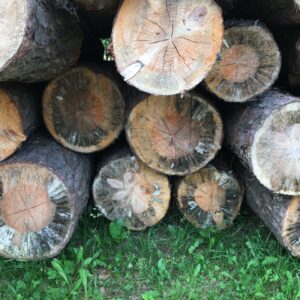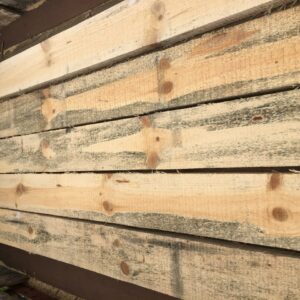So, last fall (almost 1 full year ago) we cut 26 red pines down, bucked them and piled them. There they sat until about a month ago when we started milling them. I know this is far too long to wait to be ideal, but here we are now.
Naturally, theres blue staining and I like that. But thats just the start of it. Theres green mold growing, bugs getting under the bark, and even some white mycelium growing on some of the logs. I was hoping this was all surface issues but some of the cut and stacked lumber is growing mold as well. Not sure if its from surface moisture leaving the wood or if its inside the lumber itself now.
I’m stressing! Is the structural integrity of the wood lost now? Will air drying be enough to stop this process? Will kiln drying even be enough? I dont know what to do, but I cant let 26 trees rot in my yard. If that means getting them kiln dried or treated, at least it’s usable. Also considering getting most of it turned into tongue and groove for paneling. Thinner boards will dry faster, they dont need to be structurally strong for paneling, and the spalting would be beautiful. Probably could sell enough to the right market to make money back as well, because I’m not sure how many people will buy this for framing now.
Location is Michigan’s upper peninsula and we are relatively humid throughout the summer, if that helps with anyone’s advice.
Discussion Forum
Get It All!
UNLIMITED Membership is like taking a master class in woodworking for less than $10 a month.
Start Your Free TrialCategories
Discussion Forum
Digital Plans Library
Member exclusive! – Plans for everyone – from beginners to experts – right at your fingertips.
Highlights
-
Shape Your Skills
when you sign up for our emails
This site is protected by reCAPTCHA and the Google Privacy Policy and Terms of Service apply. -
 Shop Talk Live Podcast
Shop Talk Live Podcast -
 Our favorite articles and videos
Our favorite articles and videos -
E-Learning Courses from Fine Woodworking
-
-
 Fine Woodworking New England Event
Fine Woodworking New England Event -














Replies
I know kiln drying is the way to go to prevent infestations such as post hole beetles. Kiln drying will also reduce the moisture content, thereby killing most, if not all mold.
I know kiln drying would be ideal, but definitely way more work and money. I hope air drying is sufficient, but if not, I’d rather put the money and work into kiln drying in order to actually save the lumber.
This happened to me with some Sycamore logs that I had stacked on top of cinder blocks under a tarp. I went ahead and milled them. Some of the would was so friable that it was worthless for anything, but I was surprised at how much could be used. Some went into panels. I had to patch some holes from worm damage but it looked good when patched and sanded. I made boxes for tools that I put inside an old Army chest. One had such cracked and friable dovetails that I was going to throw it away, but I glued up the cracks with hide glue and my wife uses it for Knick knacks. She liked the spalting. Once milled it dried out quickly.
I’ve got way too much wood here to use if for knick knack boxes! But a bunch of beautiful paneling would be great and also could be a money maker. After looking into some of the stacks a bit more, I think most of the mold and mycelium growth is limited to a handful of 2x6 boards from a particularly wet log on the bottom of the log pile. Most of the lumber seems to be drying well so far, despite wet stickers and lots of humidity.
If it goes too far, the wood will get punky and soft. Sapwood is affected mostly, which evident in the photos.
Not a good idea to let softwood logs set around too long. If they are, you should remove the bark that's where the larvae get started.
Lesson learned.
And being only 65 years old, a lot of these logs are sapwood. I actually assumed leaving bark on would help protect the wood from rain and whatnot. Never considered removing bark until recently but the logs should all be milled this week so I’ll skip it now.
Removing the bark almost always is the best course. Some woods, like birch will completely rot under the bark, and you'll end up with a bark tube.
And being only 65 years old, a lot of these logs are sapwood. I actually assumed leaving bark on would help protect the wood from rain and whatnot. Never considered removing bark until recently but the logs should all be milled this week so I’ll skip it now.
This forum post is now archived. Commenting has been disabled